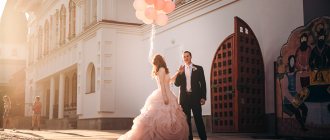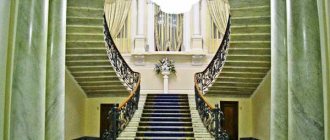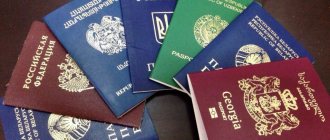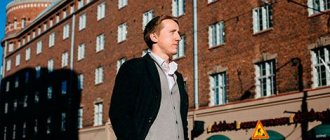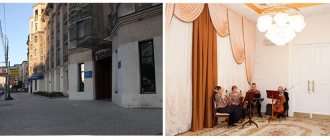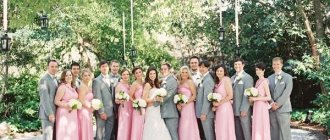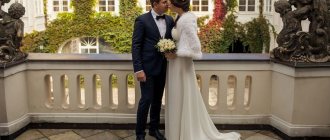About the registry office
The historical name of Wedding Palace No. 3 is the Reserve Palace. The building itself is a historical monument of a past era. The Reserve Palace was created in 1817-1824 by the architect A. Menelas, but during the hostilities the cultural monument was damaged by shelling. Until the beginning of the 21st century, the house was practically a ruin. Restoration work helped not only to revive the architectural memory of St. Petersburg, but also to find good use for it: in 2010, the Reserve Palace became the Wedding Palace No. 3 of St. Petersburg. Now the processes of registering the marriage of St. Petersburg residents take place in a unique historical building.
Address: Pushkin, st. Sadovaya, 22
Opening hours and hours: Reception of applications: daily from 10.00 to 18.00.
Break: from 14.00 to 15.00
| Telephone | Reception days | Business hours | |
| Accepting applications | 576-10-30 | Monday, Tuesday, Sunday Wednesday, Thursday, Friday, Saturday | from 10:00 to 14:00 from 15:00 to 17:00 |
| Boss - Leonova Anastasia Sergeevna | 576-10-29 | Tuesday Thursday | from 10:00 to 14:00 from 15:00 to 17:00 |
| State registration marriage | 576-10-32 | Daily | from 10:00 to 17:00 |
| Archive | 576-10-30 | Monday, Tuesday, Sunday Wednesday, Thursday, Friday, Saturday | from 10:00 to 14:00 from 15:00 to 17:00 |
Photo and design
First floor
The hall of the Wedding Palace 3 in Pushkin is small in size. On the left side you can enter the dressing area, and three guest rooms are located on the right, where guests can comfortably wait for the wedding registration to begin. A special feature of Wedding Palace 3 in Pushkin is the elevator, which anyone can use to go to the top floor. The main staircase for the standard descent of the newlyweds and a photo shoot is also present. It is narrow, so a large procession will not pass here. The main staircase consists of 6 flights.
Second floor
On the second floor of the Wedding Palace 3 Pushkin there is a ceremony hall, a separate room for the official part of marriage registration, as well as a waiting room. Separate apartments for newlyweds, in which they can prepare for the registration process, are not taken into account in the layout, so the future spouses wait before the ceremony to leave together with their guests, and sometimes with other future newlyweds.
The ceremonial registration hall enchants visitors with romantic creamy pink tones, luxurious furniture of a classic noble style, a wealth of sparkling chandeliers and colorful carpets, emphasizing the importance and peculiarity of the events taking place here in the life of every person.
The ceremony hall of the Wedding Palace 3 in Pushkin is quite spacious, but it also has its own unique feature: an internal balcony (mezzanine). Thanks to the mezzanine, a huge number of guests can watch the ceremony. This highlight of DB 3 in St. Petersburg is a wonderful place for photography. The newlyweds are signing near the colonnade at a low table, sitting on beautiful chairs with curved legs. In the middle of the hall, the newly-made spouses exchange wedding rings, which are presented to them on a platter.
Vladimir Palace
The building was restored and this was done by the architect Alexander Fomich Vidov. Then the construction of outbuildings continued, such as the Unter-Stalker's outbuilding, the Crew's barn, the Cavalier's house and others.
After the death of Prince Vladimir Alexandrovich, from 1909 the palace belonged to his widow, Grand Duchess Maria Pavlovna, who continued to manage the estate until the 1917 revolution.
In 1910, a bronze bust of Prince Vladimir Alexandrovich was installed in front of the palace. Unfortunately, only the pedestal has survived to this day. At this time, the highest permission was received to rename the Reserve Palace to Vladimir Palace.
During the First World War, representatives of the imperial family, dissatisfied with the policies of Nicholas II, gathered in the Vladimir Palace, and part of the palace was occupied by an officers' hospital.
Recommendations
- 30-40 minutes is the time it will take to arrange photography in the halls of the Wedding Palace 3. The park on the territory of the DB is also an excellent backdrop for wedding photographs.
- The covers of the passports of those getting married must be removed before registration. Witnesses will not need passports.
- To carry out photo and video shooting, you should invite specialists yourself, who will ensure high-quality recording of everything that happens at the wedding.
- According to the internal rules of the Wedding Palace 3 in Pushkin, it is not allowed to litter, shower the newlyweds with flowers, coins, candies, etc. Any type of pyrotechnics is strictly prohibited.
Details for paying state duty
Name of payment recipient : UFK for St. Petersburg
(Main Directorate of the Ministry of Justice of the Russian Federation for St. Petersburg)
Taxpayer Identification Number:7838459758
checkpoint: 783801001
OKTMO: 40303000
OKPO: 91956193
OGRN: 1117847191252
KBK: 31810805000010001110
Payee account number: 40101810200000010001
Bank name : North-West State Administration of Bank of Russia
BIC: 044030001
Name of payment: state duty for registration of acts of civil status.
Link to the official website of the Pushkin Wedding Palace
Palace of the Kochubeys
Construction of the palace began in 1817 and lasted 8 years. It was built for the Kochubey couple in 1817 - 1824 as a country palace, which for a long time bore the name of its owners.
The building was made in the strict style of late classicism, typical of Russian country palaces, which were reminiscent of Italian villas of the 19th century. A landscape park was built around the palace.
It is believed that Emperor Alexander I participated in the design of the palace. Many of the drawings retain marks made by his hand. The sovereign also involved in the construction, in turn, the architects Pyotr Vasilyevich Neelov and Adam Adamovich Menelas, and later Vasily Petrovich Stasov.
Pushkin Wedding Palace Photo
Palace under Soviet rule
During the February Revolution and during the period of dual power, the palace building was occupied by the Tsarskoye Selo Council of Workers' and Soldiers' Deputies. The executive committee of the united council was located here even after the October Revolution of 1917.
Since 1926, the ensemble of buildings of the Reserve Palace was transferred to the House of Party Education. During the Great Patriotic War, the Reserve Palace was destroyed, only the walls survived. In the 1950s, the palace had to be practically rebuilt from scratch. The youth of the city of Pushkin took an active part in its restoration.
From 1958 to 1976, the palace housed the Pushkin House of Pioneers. For several years, a local history exhibition was located here; in the late 1970s, it moved to a new museum building.
Wedding Palace No. 3 Pushkin Small Hall
Link to a wedding photo shoot at Wedding Palace No. 3 Pushkin
Interior
The ceremony hall is very spacious and can accommodate about 20 guests. The room is designed in gray and blue tones. The hall has a special place for a musical orchestra, and a crystal chandelier adds significance and luxury to the room.
Recommendations
- Parking on the day of registration should be thought out in advance, since on days of special events there are a lot of cars and there may not be enough space for everyone.
- Since the influx of people getting married at Wedding Palace 3 is large, applications are accepted at least 2 months before the expected date.
Address: Moscow, Yunykh Lenintsev, 35, bldg. 1 Contacts and telephone: Hours and opening hours: Tue.-Sat. from 9.00 to 18.00 Break from 14.00 to 15.00.
How the city of Pushkin was revived
In Swedish times (1609 - 1702) on the territory of the Catherine Palace there was an estate of a Swedish magnate - Sarskaya Manor (Finnish Saari mojs, Swedish Sarishoff - “elevated place”). It was a small estate, consisting of a wooden house, outbuildings and a modest garden, divided by two perpendicular alleys into four squares. This settlement was first mentioned as part of the Nikolsky Izhora churchyard in the “Census salary book for Novgorod of the Votskaya Pyatina of 1501. On the maps compiled for Boris Godunov, the estate is called “Saritsa”. Later, under the influence of Russian folk etymology, the name was transformed into “Sarskaya Manor”, then into “Saarskoe Selo”, and finally became Tsarskoe Selo.
After the expulsion of the Swedes from this area, Peter I donated the manor to A.D. Menshikov, and later, on June 13, 1710, by decree of the emperor, the Sarskaya manor (together with 43 assigned villages and lands) was donated to Martha Skavronskaya, who became his wife in 1712 under the name Ekaterina Alekseevna. This date, June 13, 1710, is the founding date of the city. In 1718 - 1724, according to the design of the architect Johann Braunstein, a small two-story stone palace, surrounded by outbuildings, grew here. The garden expanded, re-planned with terraces by the master of gardening art J. V. Roozen, in 1719 and 1722 two ponds were dug on the lower terrace.
Not far from the palace a settlement of palace servants arose. In 1716, the wooden Assumption Church was built: from that moment the Sarskaya manor turned into Sarskoye Selo. In 1720, the first street of Tsarskoe Selo appeared - Sadovaya (The original name was Front Street). In 1721, the Kuzminskaya settlement was established from the peasants of the Suzdal province. In 1734, construction began on the Znamenskaya Church, the oldest stone building in the city.
